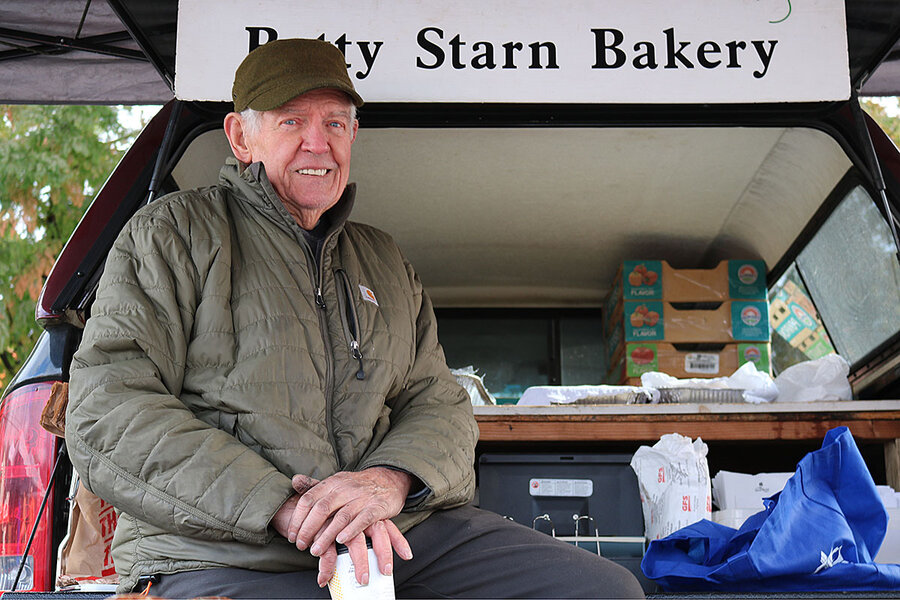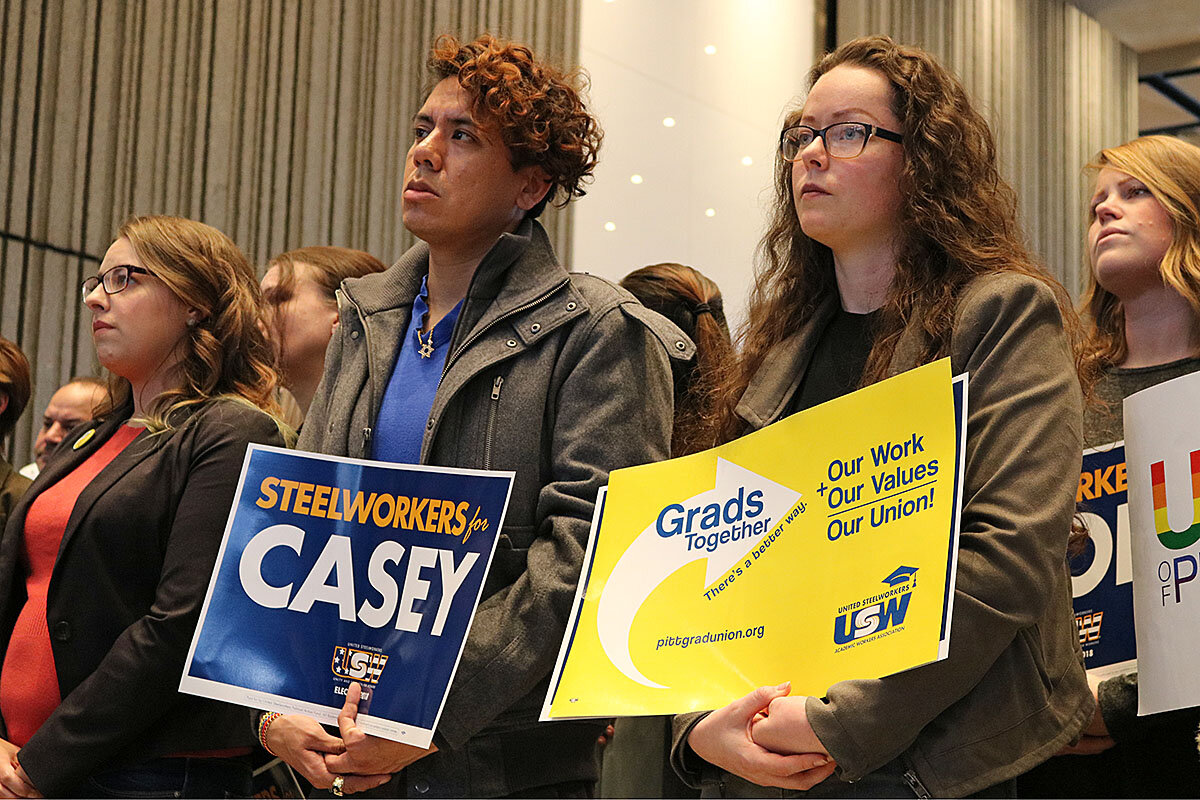In Midwest swing states, a 'red wall' for Republicans could crack
Loading...
| BEAVER, PA.
Bill Sarten was worried about his guns.
The lifelong hunter had seen the ads warning voters that Hillary Clinton would leave them defenseless. He’d heard the speeches calling her the most anti-gun candidate ever to run for president. And he’d chafed at the thought of an administration that would erode his Second Amendment rights.
So in November 2016, Mr. Sarten voted for President Trump.
Why We Wrote This
Two years ago no region proved so pivotal in the presidential race as the so-called Rust Belt. It’s still crucial two years later, in play again as some voters appear to question their loyalties to Trump.
“That was a mistake,” he says now.
Sarten, a longtime Republican, says that on Tuesday he plans to vote for Gov. Tom Wolf and Rep. Conor Lamb, both incumbent Democrats on his ballot. Their message about expanding health care resonates with Sarten, who’s 84. More than that, he’s not a fan of the hostile tone Mr. Trump has been setting, or the candidates from his party that have embraced it.
“I really hate that stuff that he’s got against immigrants,” Sarten says, shaking his head. “How can you be like that? It’s when guys go against immigrants and everything like that, that causes that guy like in Pittsburgh” – who shot and killed 11 people at a local synagogue – “to go goofy.”
Sarten was one of nearly 3 million Pennsylvanians who helped usher Trump into the White House in 2016, handing the state to a Republican presidential candidate for the first time in 30 years. In the aftermath, Democratic strategists fretted that Pennsylvania, a swing state that leaned blue, had perhaps begun to tip irreparably red.
Two years later, those fears haven’t panned out. In March, Mr. Lamb won a major upset in a special election in the state’s deeply conservative 18th district. Today the state’s House races appear likely to split about evenly by party. The Democratic incumbents running for statewide office have racked up such big leads against their Republican challengers that a pair of analysts have called the races “boring.”
It’s a pattern that’s playing out in other key Midwest and industrial states – like Ohio, Michigan, and Wisconsin – that Trump narrowly won in 2016 and where Democratic candidates are pitching messages of sensible governance to voters.
The president still has plenty of supporters in these states, fighting hard for his agenda and his party. And as we saw two years ago, nothing is final until voters actually cast their ballots. But it seems the Trump effect hasn’t been very rewarding for Republicans in purple states that went red in 2016.
In Pennsylvania, it helps that Democrats are fielding incumbents at the top of the ticket. A newly redrawn congressional district map has also made the state’s House races more competitive for Democrats than they have been in years. And more broadly, the president’s party almost always loses ground in midterms.
Still, the political landscape here just a day before the election raises the question of whether the style and message that worked so well for Trump two years ago somehow just hasn't translated to other Republican candidates in the region – or if it has even given Democrats a boost.
“All midterm elections, to a greater or lesser degree, are a referendum on the president,” says Terry Madonna, director of the Center for Politics and Public Affairs at Franklin and Marshall College in Lancaster, Pa. “This is greater than any I’ve seen in modern history. Essentially people are voting because of Trump.”
A region-wide trend
Political analysts point out that Democrats are doing best in the states Trump took by a narrow margin.
In Ohio, which he won by 8 points, Democratic Sen. Sherrod Brown has been coasting to reelection on a platform of caring for veterans and expanding access to health care. Republicans had hoped to pick off Democratic Sen. Tammy Baldwin in Wisconsin, after Trump shocked Democrats there two years ago, but she’s managed to maintain a double-digit lead against challenger Leah Vukmir by balancing a progressive agenda with a reach-across-the-aisle persona.
In Michigan, some Republicans insist businessman John James can win, but most polls show him trailing Sen. Debbie Stabenow by about 10 points. The state’s gubernatorial race also has Democrat Gretchen Whitmer holding a strong lead over Republican Bill Schuette, thanks in part to her catchy promise to “fix the damn roads.”
Trump’s victory in Pennsylvania, while surprising and significant, was also slim. He only won the state by about 44,000 votes. “To say, after 2016, ‘Hey, Pennsylvania has gone Republican,’ would have been a vast oversimplification,” says Christopher Borick, director of the Muhlenberg College Institute of Public Opinion in Allentown, Pa.
And right now the winds are blowing the Democrats’ way. At the top of their ticket are Governor Wolf and Sen. Bob Casey, neither of whom are particularly exciting, but who are familiar, steady incumbents. Their Republican challengers, former state senator Scott Wagner and Rep. Lou Barletta, have failed to gain traction in either fundraising or the polls despite the way they’ve modeled themselves after Trump.
In one campaign video, Mr. Wagner infamously advised Wolf to put on a catcher’s mask, “because I’m gonna stomp all over your face with golf spikes.” (He later apologized for the remark, calling it a “poor metaphor.”)
“Wagner punches people. Not that he’s less competent, but that persona, maybe it works in Montana. It doesn’t really work in Pennsylvania,” says Melissa Hart, a Republican strategist and former congresswoman who represented the state’s 4th district. “I think if we had nominated a more middle of the road [candidate], we would have done better.”
At the House level, the state Supreme Court’s recent decision to redraw district lines here has shifted a 13 to 5 advantage for Republicans in Congress to a possible even split, if not a 10 to 8 edge for Democrats.
The energy sweeping through the left is one of the factors. Candidates who tailor themselves and their messages to the region – by talking about health care, job security, and practical governance – have a good chance of riding that potential wave, says Mr. Madonna.
Jojo Burgess, a steelworker at a transformer plant in Canonsburg, about 20 miles southwest of Pittsburgh, recalls how his fellow union members just didn’t seem motivated to hit the polls two years ago. “A lot of people lost interest,” he says at a rally at the United Steelworkers headquarters in Pittsburgh, spitting distance from the Ohio River. “People saw Hillary Clinton was up big, so they said, ‘Well we ain’t going to go.’ ”
This time around Mr. Burgess is working to ramp up get-out-the-vote efforts. But he only campaigns for candidates he says reflect working class values like fair labor, access to health care, and job security.
Ryan Prah, who works at the mill in nearby Clairton, also showed up to the rally – and says he liked what he heard. A Coast Guard veteran who loves his guns, Mr. Prah hated seeing the ordeal Cuban migrants were put through as they tried to cross by boat into Galveston, Tex., where he was stationed in the early 2000s. The speeches that Wolf, Senator Casey, and Congressman Lamb made, peppered with references to “the common man” and “the American worker,” hit home for him.
“There’s a lot of people out there that are blowing a lot of smoke, just to get the support of the AFL-CIO,” he says, “but they don’t have a brand or a mind of their own. All these ones do, 100 percent. That’s why I’m here.”
Republican determination ... and doubts
That’s not the prevailing view at the Beaver County Farmers’ Market in Western Pennsylvania.
The Saturday before the election, about a dozen or so vendors brave the chill gray morning to sell crisp produce, fresh breads, and hot food. Most here say they support the president and plan to vote Republican on Tuesday – not surprising in a county that went to Trump by 18 points.
For some, like Patrick Michael, it’s clear-cut: The Democratic Party has lurched too far left. Voters who care about law and order and preventing the US from sliding into socialism need to support the GOP. “I’ve never, ever voted straight Republican or straight Democrat until this election,” Mr. Michael says as he offers stuffed grape leaves and baked kibbeh, traditional Lebanese dishes, for customers to try. “I’m going to go straight Republican on Tuesday.”
Others are less certain. Wayne Harley, who runs the century-old Oak Spring Farm in nearby New Brighton with his wife and youngest son, wants to see leaders who understand issues that affect farmers. He’s not convinced that Wolf, or any Democrat on the ticket, does. He’s also a devout Christian and staunchly pro-life. So Mr. Harley votes Republican.
But he wavers on immigration. As a farmer, he gets the need for migrant labor. He’s also sympathetic to the families in the so-called caravan making its way up from Honduras to the US-Mexico border. They’re the kind of folks his second son, an immigration lawyer, represents.
“It sounds like they’re trying to get out of there. Save their lives and try to find a better life for their kids,” Harley says, watching his youngest unload produce from their truck onto long tables they’ve set up for the sale.
He pauses. “I don’t know how it’s all going to play out.”
Across from the Harleys’ stall, Philip Floyd and his sister Laurie chat with customers looking through their display of pumpkins and squash. Like many here, Mr. Floyd cherishes gun rights, and he intends to use his midterm vote to protect them. The killings at the Tree of Life Congregation in Pittsburgh, however, left him horrified.
“It almost makes me feel a sense of guilt, because this guy legally owned his gun,” Floyd says of the shooter. He adds that thousands of gun owners out there would never do anything so awful. “I don’t know what the answer is, except there is a lot of hate in the country right now.”







